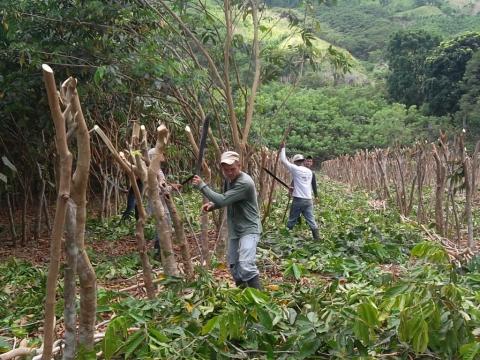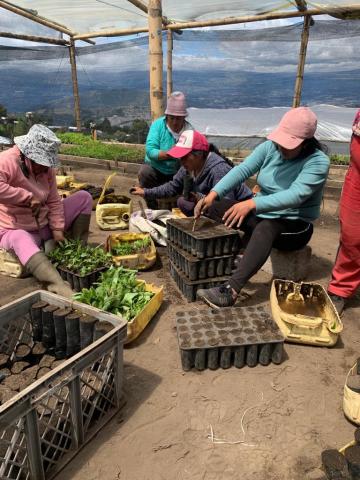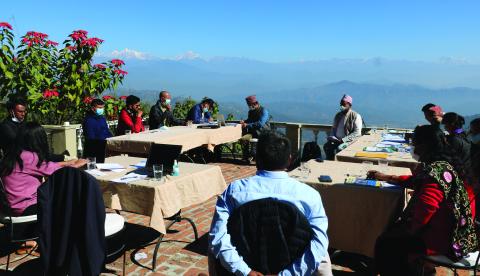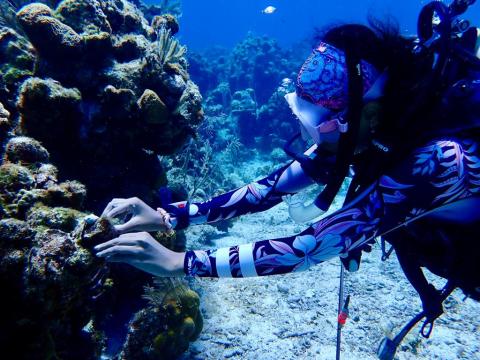Lessons for the GST: Learning from local adaptation pioneers to enhance transformational climate action
Lessons for the GST: Learning from local adaptation pioneers to enhance transformational climate action
A headline finding of the first-ever UNFCCC Global Stocktake (GST) is that countries need to support “systems transformations” that mainstream climate resilient development to step up our response to the climate crisis. But how can UN member states at COP28 respond to this call without a tangible sense of what this looks like in practice?
This article shares a range of adaptation and resilience responses with transformational potential that frontline communities and organisations are leading in the global South. If global talks and actions of international and national actors pay heed to these messages, it could help deliver a “course correction”. But first, the Global Stocktake needs to reflect these diverse local voices.
By CDKN’s Lisa McNamara, Mairi Dupar, Nadia Sitas and Karen Hildahl. Highlighting the stories from Constance Okolett, Lourivania Soares Santos and Mike Hands.
At COP28, governments will be agreeing the text of the first Global Stocktake to report on progress in implementing the Paris Agreement to date and guide a “course correction” for future climate-action pathways. However, without grounded and nuanced understandings of what transformational climate action is already taking place in diverse local contexts, we continually risk falling back on business-as-usual development.
Local champions in the global South are pioneering transformational resilience and adaptation actions in diverse geographies around the world – and have the potential to inspire the action and support of others.
Many of these examples, and the resulting recommendations, are showcased in the Stories of Resilience: Lesson from Local Adaptation Practice 2023 study by the Global Center on Adaptation and CDKN. We conducted a local stocktake of our own with local actors, basing our findings on more than 200 contributions from a call for stories, and deeper exploration of 19 locally-led initiatives around the world.
Transformational climate action is where people and nature flourish
The science is clear that the biodiversity and climate crises are deeply interlinked and must be tackled together in ways that support people’s lives and livelihoods, both now and into the future. Climate change is one of the main drivers of biodiversity loss and exacerbates the impact of climate hazards.
Most of the 2023 Stories of Resilience focused on restoring environmental integrity, especially in agriculture and food systems, and showed how local pioneers are spearheading ecosystem restoration efforts and trying to develop ecologically-regenerative systems – often with minimal funding.
These stories underline that Indigenous People and local communities are deeply dependent on biodiversity and ecosystem services for survival and are also consequently the most effective environmental defenders. They show that halting or reversing the destruction of natural resources and environmental defence is a core adaptation strategy and way of strengthening local communities’ adaptive capacities.
Farmer-led agroforestry in Honduras
In Honduras, farmers are using a native Inga tree to nourish tropical soils and restore fertility using the ‘Inga Alley Cropping method’ as a proven alternative to slash and burn agriculture, otherwise known as shifting cultivation.
This is tackling both rainforest destruction and declining land fertility from slash-and-burn methods. The Inga Alley Cropping involves creating alleys lined with the nutrient-fixing trees, within which farmers can produce food crops like beans and maize for their families’ survival, as well as cash crops for sale.
It has been demonstrated to provide food and income security and completely eliminate the need for environmentally-destructive slash-and-burn methods that destroy forests. The trees also enhance climate resilience to droughts and floods. Enhanced soil organic matter acts as a sponge, retaining water and releasing it slowly.

Thanks to demonstration sites, its popularity is now spreading significantly among Honduran farmers with the potential to spread much wider. The programme started with 40 families and has added 40 more families each year; now exceeding 450 families.
"There are no loans, debt or microloans – the programme is by and for the families as they are trained at their plot and make all planting decisions. Slash-and-burn stops as soon as a family plants their basic grain alley of hedgerow plantings of Inga tree species. All have 100% food security in 18-24 months and none have gone back to slash-and-burn" – Mike Hands, Inga Foundation
Read more here in the Stories of Resilience
Achieving women’s and girls’ human rights in a climate changing world is transformational
Achieving women’s human rights and gender equality (and the road towards this) represents transformational change. Climate change impacts and society’s responses to climate change put women’s and girls’ human rights even more under threat. It is urgent that we close this increasingly widening gender development gap for people’s wellbeing and climate resilience.
Uganda’s women’s network shifting norms by organising for adaptation action

Osukuru in eastern Uganda is an area highly exposed and vulnerable to climate-related disasters, especially flooding. A local health worker, Constance Okollet, banded together with 12 other health workers to form the Osukuru United Women’s Network to improve the physical and mental wellbeing of their community members. This group grew to a force of 2,000+ women helping each other, working holistically to bolster their collective resilience to tackle compounding problems of floods, food and income insecurity, as well as gender-based violence and HIV and sexually transmitted diseases from a prevalent sex trade in the town.
The network initiated savings and loans associations and supported women to develop productive, climate-resilient kitchen (vegetable) gardens.
"Savings can take away some of the problems because we tell our women members: Why don’t we save and stop selling ourselves to the cheap men and the STDs [sexually transmitted diseases]? Most are victims of HIV/AIDS. So, we change them from sex work to businesses, to educate their children, to help their parents… People will tell you the reason they want to join sex work is to take their child to school. When you talk about the kitchen garden, you will have food year in and year out, you will have cassava and potatoes, and the kitchen garden doesn’t need a lot of water. You take the water remaining from washing plates and you pour it on there and it gains the health, the food. So, you find a lot of activities came out of the floods and the harsh weather, and the drought and disasters that destroy" – Constance Okollet, Founder, Osukuru United Women’s Network
Members pursue a variety of climate-resilient development activities including conserving wetlands – moving away from historically growing food in the local wetlands and draining water off into ditches – and collectively cultivating and processing Cassava, the area’s staple drought-resistant crop, to bolster their food security and income.
This story shows how women organising for adaptation action has shifted norms in the community and the women’s confidence and men’s respect for the women and their rights has grown. In the beginning, most men in the community were highly resistant to the Network. Some even forbid their wives to participate. But the women persisted, and over time, men became actively supportive. The key, says Constance, was women’s economic empowerment through climate resilience actions: this has reduced stress in households, reduced friction and domestic violence.
Read more in the Stories of Resilience
Transformational climate action is multi-dimensional and integrative
A GST headline finding is that globally, “most observed adaptation efforts are fragmented, incremental, sector-specific”; however this imperfectly represents the realities of local communities in the global South, where there is growing evidence that responses are more holistic and often providing multiple benefits across ecological, social and economic domains.
Importantly, it is a question of scale. At the local level, adaptation leaders and communities often see the whole picture and interconnectedness of issues. The silo-isation and fragmentation happens at larger scales and means that communities’ adaptation progress can be quite precarious: subject to being undermined – unless they succeed in partnering with other actors for policy, legal, fisal-financial, technical and institutional changes at multiple scales, that affect their local area.
Rede Pintadas (Pintadas Network): Building solidarity around integrated and just climate action
Northeast Brazil’s Bahia state has been semi-arid over human history, but climate change is making drought increasingly persistent. In this context, the Rede Pintadas (Pintadas Network) has a long history of organising to support climate-resilient livelihoods and local people’s wellbeing, including women’s rights, in traditional rural communities.
The Pintadas Network have been successful in advocating for and securing state laws for recognition of biocultural heritage of local indigenous umbu fruit- and licuri palm tree-based products, which helped grow the market for these specialties and critically, brought in legislation to protect then from unsustainable cutting.
The effectiveness of the Rede Pintadas has hinged on the holistic nature of its activities, which prioritise: climate-compatible, cooperative-based economic development, including agroecological methods; the assertion of gender equality and women’s and young people’s empowerment; and a strategic focus on demanding new laws and policies to enable locally-led adaptation.
"We want to demand water security, technology for agricultural production appropriate to the semi-arid region, education, and investment in research into the potential of the caatinga, cultural policies so that we can continue our work of empowering communities and young people" – Lourivânia Soares Santos, journalist and activist, Rede Pintadas
Read more in the Stories of Resilience
Transformational climate action is accountable
Transformational climate action fosters a shared sense of responsibility and accountability to those most affected by climate change.
Water Funds in the Andean region: Multi-actor finance that responds to the needs and interests of diverse local actors

Water Funds show the importance of locally-led and accountable processes. They are long-term financial mechanisms and multi-actor governance spaces where local private sector, government and community actors come together to ensure the protection of water sources. The first Water Fund was created in Quito, Ecuador 20 years ago and they have since been replicated across Latin America and other parts of the world. FFLA-CDKN has been supporting an Andean Water Fund Platform that brings together ten Water Funds in Colombia, Ecuador and Peru.
To be successful, Water Funds need to be participatory and accountable to local people’s needs. Trust is an important element, including whether communities consider themselves represented in the programme design (as opposed to programmes being imposed from the outside). Listening to and learning from community members who deeply know the lands and people that Water Funds aim to influence is fundamental. Moreover, there is a link between programme durability and attention to equity and justice, which points to the importance of a social perspective in the work of Water Funds (learn more).
Water Funds result in multiple co-benefits, including carbon capture, biodiversity conservation, ecosystem-based adaptation and climate resilience for vulnerable local and indigenous communities. Strategies include conservation, restoration, sustainable use, education, outreach, impact monitoring, reporting, accountability and gender equality and social inclusion. Activities are financed by the local private sector, government and residents in cities that depend on access to water in the catchment area.
Transformational climate action weaves together diverse knowledge types and co-creates responses
The complex nature of the climate challenge means that sources of knowledge (local, traditional, scientific and experiential) and diverse perspectives need to be brought to bear in co-designing and implementing effective responses. Many examples are surfacing of how this can be practically achieved and potential conflicts and contestations mediated for more co-owned, and effective, outcomes.
Collaborative urban water management bridges knowledge and action in Nepal
In Nepal, the Southasia Institute of Advanced Studies (SIAS) created spaces through water dialogues (called Pani Chautari) to co-develop responses to water management in the town of Dhulikel, over four years (read more here).
This work weaved together different voices and knowledge for more equitable, accepted and locally-owned solutions that helped to respond to water supply conflicts among upstream rural and downstream urban communities.
Collaborative prioritising and piloting of proposed measures to address water challenges helped to bring together evidence from multiple knowledge types. For example, local, expert, traditional and experiential knowledge from community-based water user committees complemented scientific assessments of water availability and access. Partnerships were also created for their design, testing, funding, implementation and monitoring. This ensured ownership and sustainability, bolstered by the local authority institutionalising Pani Chautari through the formation of a water council to support collaborative water management into the future.

Transformational climate action is adaptive, inventive and anticipatory
Around the world, innovative climate action is emerging that is using creative and experimental ways to finance and scale impact, and respond to current and future climate change, grounded in strong partnerships.
Regional funding partnerships for reef protection in Honduras, Belize, Guatemala and Mexico
After hurricanes hit around Honduras, Belize, Guatemala and Mexico, repair teams dive down to clear debris from coral reefs. They recover coral fragments, buried under the sediment by strong storm currents. They also remove the litter and solid waste washed into the reef.
Whatever fragments are still alive are reattached. This must be done within two weeks of hurricane impact to avoid permanent damage to the coral ecosystem.
How is it financed? The Mesoamerican Reef (MAR) Fund helps to procure insurance policies for these emergency reef repairs at 11 reef sites, primarily in Honduras, and trains the emergency response divers. The mission of the MAR Fund is to drive regional funding and partnerships for the conservation, restoration, and sustainable use of the Mesoamerican Reef.
A key innovation of the MAR Fund’s approach was to consolidate insurance coverage for multiple sites to help reduce the cost of premiums. The insurance coverage includes stipends to reimburse the reef divers for their time and expertise.
Two of the sites were insured using a grant from the Adaptation Fund, which supports climate innovation in developing countries through its Small Grant Aggregator Platform (ISGAP).

Who needs to do what next to support transformational climate action?
The examples above show that pockets of transformational change are already happening through the sheer ingenuity, will, leadership and solidarity of climate-affected communities, community organisers and networks, governments, researchers, businesses, financing entities and their partners.
A “course correction” at COP28 needs to move us towards transformational climate action and tackle the systemic causes of the climate crisis, biodiversity loss and structural inequalities:
- Community adaptation initiatives and perspectives are invisible in the GST. Future stocktakes need to consider ways for these local stories and experiences to feed more directly into the Stocktake through, for example, ‘local stocktakes’ and via intermediaries such as solidarity and community networks, local non-governmental organisations, local universities and research groups – that together can provide a rounded and aggravated view of local adaptation practice in the global South. These efforts should be oriented towards collective learning by communities and social groups to further deepen and extend impact as opposed to monitoring for its own sake.
- Supporting local communities’ defence through foregrounding their rights to natural resource access and use, particularly Indigenous land, and halting natural resource degradation, needs to be recognised as an adaptation priority of the highest order for government, development financiers, private landowners and private businesses. This requires adequate environmental law enforcement, and attention to resolving conflicts over natural resources between communities and external actors.
- Governments, businesses, multilateral agencies, funders, programme leaders, non-governmental and civil society organisations need to step up their ambition on gender equality and human rights, which must be seen as fundamental to achieving transformational climate action. Gender equality and climate action must not only be prioritised in their own right, but also be effectively integrated together, in policy and practice. Unless vulnerable and/or marginalised groups, including Indigenous People, are explicitly engaged and accorded leadership of climate action, they are unlikely to access the full benefits. They could even face ‘maladaptation’ – a weakening of their resilience. Sign up to the COP28 call to action for gender just, low carbon economies here.
- Catalysing investment in Ecosystem-based Adaptation (EbA) and Nature-based Solutions (NbS) must be a core strategy for governments, international climate funds, bilateral donors, development banks and philanthropies. It is estimated that less than 2% of all public international climate finance goes toward NbS for adaptation despite its enormous potential for countering the interconnected biodiversity and climate crisis and multiple co-benefits for people.
- Community groups and solidarity movements are already working with each other and tackling structural inequality and discrimination as well as building climate resilience, but their impact is severely constrained by a lack of resources. These initiatives led by women and marginalised groups need to be funded and supported to be able to link in solidarity with other communities to exchange tactical and strategic knowledge, and provide important moral support and amplified political voice to support each others’ efforts.
- Funders and investors need to strengthen local capacities and trust local actors with resources and resource allocation so they have the power to decide their own adaptation needs and priorities, which will enable more finance to reach where it is most needed. Financial intermediaries need to be willing to give up power and decision-making as well as resources.
- Funders and governments need to transform adaptation finance to the more holistic ways in which resilience and adaptive capacity is being built on the ground. ‘Climate rationales’ required by funders are too narrow and need to be broadened to account for the multiple pathways to climate-resilient development, such as tackling gender-based violence, and move beyond just ‘technical’ adaptation activities like building physical infrastructure or supporting the adoption of climate-smart technologies.
- The role of knowledge brokers needs to be recognised in bridging the knowledge to action gap and working towards system-wide systems change. These intermediaries work across sectors, scales and with multiple stakeholders to connect and weave together diverse types of knowledge for more inclusive and evidence-based responses. They can help to navigate significant barriers to action like societal rules, institutional fragmentation, politics and power asymmetries, and competing values and aspirations about the future.
